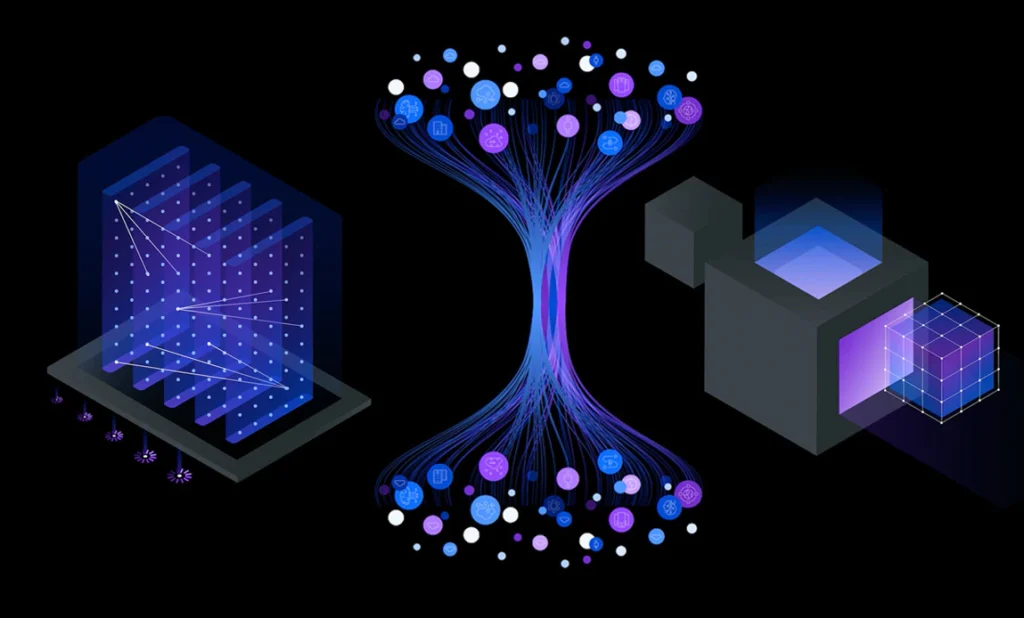Data fabric is a new concept that refers to a unified and integrated platform that enables data management, data access, and data analysis across multiple data sources, types, and locations. It provides a comprehensive view of the data landscape by consolidating data from disparate sources into a unified view.
The concept of data fabric is based on the idea of creating a seamless and efficient way of managing data across the entire data lifecycle, from data ingestion to storage, processing, and analysis. It allows organizations to create a highly scalable and agile data environment that can adapt to changing business needs.
This article explains the challenges, benefits, key components, and the future of the data fabrics that will become beneficial for everyone.
Key components of a data fabric
The key components of a data fabric enable organizations to manage and analyze their data more efficiently, providing a unified and integrated platform for working with data across the organization. Some of them are:
- Data integration: Data fabrics are designed to compile data from different sources and systems, enabling organizations to work with data more efficiently. Data integration capabilities are a critical component of a data fabric.
- Data governance: Data fabrics provide a comprehensive view of the data landscape, making it easier for organizations to manage and govern their data. It includes data quality, security, and regulatory compliance.
- Data management: Data fabrics provide a centralized platform for managing data, including data storage, data processing, and analytics.
- Data analytics: Data fabrics enable organizations to analyze data in real time and generate insights more quickly, allowing them to make more informed decisions.
- Data security: Data fabrics provide robust security capabilities, including encryption, access controls, and other security measures to protect data from unauthorized access and breaches.
- Data scalability: Data fabrics are designed to handle large volumes of data and scale as needed, allowing organizations to grow and expand their data environment.
Challenges of managing data in today’s world
Managing data in today’s world can be challenging for organizations due to several factors such as the proliferation of data sources, the increasing complexity of data structures, and the growing demand for real-time data insights. Some of the challenges that organizations face in managing data include:
- Data silos: Many organizations have data silos, where different departments or teams store and manage data in separate systems that are not integrated. It can lead to inefficiencies, duplication of effort, and difficulty in accessing data across the organization.
- Data quality issues: Ensuring data quality is quite a challenge for organizations, especially when their data comes from different sources or is in various formats. Poor data quality can lead to incorrect insights, bad decision-making, and other business problems.
- Regulatory compliance: Organizations must comply with various data privacy and security regulations, such as GDPR and HIPAA. Ensuring compliance with these regulations can be challenging, especially when dealing with sensitive data.
- Data security: Data breaches can have high consequences for organizations, including financial losses, damage to reputation, and legal action. Organizations must take steps to ensure the security of their data, including implementing encryption, access controls, and other security measures.
Overall, managing data in today’s world can be a complex and challenging task for organizations. But it also comes with several benefits.
Benefits of data fabrics
Data fabrics can be termed the future of data security and management. Some of the soundest benefits of using it are:
- Increased agility: Data fabrics enable organizations to quickly and easily access and analyze data from multiple sources, allowing them to respond faster to changing business needs.
- Improved scalability: Data fabrics are highly scalable and can handle large volumes of data, allowing organizations to grow and expand their data environment as needed.
- Enhanced data governance: Data fabrics provide a comprehensive view of the data landscape, making it easier for organizations to monitor and enforce data policies and comply with regulatory requirements.
- Faster insights: Data fabrics enable organizations to analyze data and generate insights faster, allowing them to make quick and more informed decisions.
Examples of companies using data fabrics
Several companies across various industries use data fabrics to manage and analyze their data in an efficient way. Here are some examples:
- Netflix: Netflix uses a data fabric called Metaflow to manage and analyze its data. Metaflow allows Netflix to streamline its data management processes, improve data quality, and generate insights faster.
- American Express: American Express uses a data fabric called Amex Data Fabric to compile data from different sources and systems into a single, unified view. It has helped American Express to improve its decision-making, reduce operational costs, and increase efficiency.
- Uber: Uber uses a data fabric called Michelangelo to manage and analyze its data. Michelangelo allows Uber to use data from different sources and systems and generate real-time insights, enabling the company to make faster and more informed decisions.
Future of Data Fabrics
The future of data fabrics looks bright, as organizations increasingly look for ways to manage and analyze their data more efficiently. Data fabrics are expected to become more sophisticated, with advanced machine learning and artificial intelligence capabilities, as well as increased automation and self-service functionality.
One of the key trends in the future of data fabrics is the shift towards cloud-based platforms, which offer greater scalability, flexibility, and cost-efficiency. It is expected to drive the adoption of data fabrics across a wide range of industries and organizations.
Another trend is the integration of data fabrics with emerging technologies such as the Internet of Things (IoT), blockchain, and edge computing, enabling organizations to work with data in new and innovative ways.
Conclusion
The future of data fabrics is likely to be characterized by continued growth and innovation. Organizations seek to unlock the value of their data and gain a competitive edge in the marketplace. As data volumes continue to grow and data becomes increasingly complex, data fabrics will play an increasingly important role in helping organizations to manage and analyze their data more efficiently and effectively.



